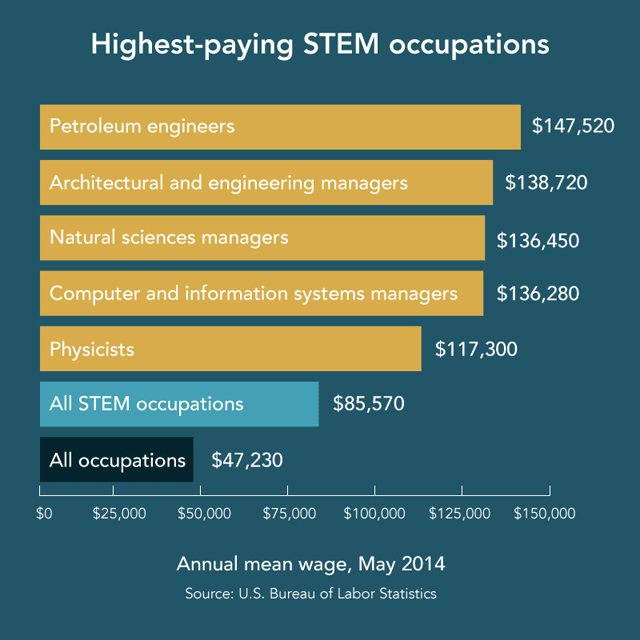7 things to know about STEM careers
Occupations employing the largest percentages of Americans often don't pay well, and it's likely little surprise that fatter paychecks can be found in the seemingly harder-to-land jobs in science, technology engineering and math, the so-called STEM jobs.
The more than 8.3 million STEM jobs counted by the U.S. Bureau of Labor Statistics in May 2014 represented 6.2 percent of total U.S. employment, roughly the same as those working as lesser-paid retail salespeople or cashiers. Those two occupations combined made up nearly 6 percent of all U.S. employment, at 4.6 million and 3.4 million, respectively.
Statistics released last summer by the U.S. Census Bureau found roughly three-quarters of those with a bachelor's degree in STEM fields are not working in those professions.
But for those considering a STEM career, here are seven things to consider, according to the U.S. Department of Labor's blog:
1. The average wage for all STEM occupations is $85,570, nearly double the average for all occupations, with just five out of the 100 STEM jobs paying below that figure. Of the 10 largest U.S. occupations, only registered nurses, with an annual mean wage of $69,790, topped the average for all jobs, which is $47,230.
2. Seven out of the 10 largest STEM occupations are related to computers, with 686,470 employed as applications software developers, 563,540 as computer user support specialists and 528,320 as computer systems analysts.
3. The 8.3 million STEM jobs as of May 2014 is up from 7.6 million in 2010, and now represents about 6.2 percent of total U.S. employment.
4. Several of the U.S. industries with the highest mean wages are STEM-related, including software publishers, computer equipment manufacturing and scientific research. The highest-paying STEM occupations are petroleum engineers, with an average mean wage of $147,520, and physicists, who earn an annual mean wage of $117,3000.
5. Some STEM jobs are more concentrated in specific geographic areas. Massachusetts and Virginia had about 2.9 and 2.6 times as many systems software developers, respectively, as the U.S. overall. Those two states were also among those with the highest percentage of STEM employment.
6. Wages for specific STEM jobs can differ greatly in different industries. Computer systems analysts who work in motor vehicle body and trailer manufacturing might make $58,940 a year, but computer systems analysts working in support roles for mining might make $118,770.
7. Pay for specific STEM jobs varies by geography. San Jose-Sunnyvale-Santa Clara, California, is the highest paying metropolitan area for system software developers, with an annual mean wage of $138,410. Wages for the same job in other metro areas ranged from $52,720 in Lafayette, Louisiana, to $124,220 in the Oakland-Fremont-Hayward, California, metro area. Systems software developers in North Dakota had an annual mean wage of $68,580 versus $124,070 in California.
